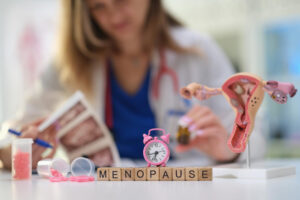The latest research reveals a striking contrast: while 70% to 80% of women face menopause symptoms that impact their quality of life, only 5% of US women use hormone replacement therapy as treatment.
Research from the Women’s Health Initiative (WHI) in 2002 caused hormone replacement therapy rates to plummet from 8.6% to 2.8%, and then drop further to 1.9% in the following two years. Recent studies now challenge many of these earlier concerns. Many women need help with menopausal symptoms – 40% to 60% seek treatment. Still, about 20% wait more than a year before getting help. The safety question remains central to this discussion. New research shows that women under 60 face minimal risks when they use hormone therapy to manage troublesome menopausal symptoms. The medical community has taken a fresh look at hormone replacement therapy’s benefits and risks. Modern advances include micronized progesterone formulations that show no increased breast cancer risk.
Let’s get into the evidence behind these changing views and see why healthcare providers now take a different approach to HRT based on current science.
Updated Clinical Indications for Hormone Replacement Therapy
Clinical evidence points to four main cases where hormone replacement therapy (HRT) shows substantial benefits. Scientists keep learning more about the best times to use HRT with minimal risks.
Vasomotor Symptom Relief in Perimenopausal Women
Hot flashes, night sweats, and palpitations affect about 80% of menopausal women as vasomotor symptoms (VMS) [1]. Systemic estrogen therapy works best as a first-line treatment and reduces these symptoms by more than 75% in most women [1]. The Postmenopausal Estrogen/Progestin Interventions trial showed that both estrogen alone (OR, 0.42) and estrogen-plus-progestin (OR, 0.38) reduced VMS substantially compared to placebo [2]. Most experts now prefer micronized progesterone to protect the endometrium because it might be safer [1].
HRT for Premature Ovarian Insufficiency (POI)
POI affects 1% of women under 40 and needs a different treatment approach [2]. These patients need HRT not just to manage symptoms but to replace hormones their bodies lost too early. Doctors recommend continuing HRT until these patients reach the typical age of natural menopause (50-51 years) [3]. Studies reveal that women with POI face 1.5-3 times higher fracture risks than those who experience menopause after 50 [3]. The right HRT treatment helps reduce heart risks, builds stronger bones, and eases psychological effects in these patients [3][4].
FDA-Approved Use for Osteoporosis Prevention
The FDA has approved several HRT formulations specifically for preventing osteoporosis [5], though the USPSTF advises against using HRT just for this purpose [2]. Research shows HRT reduces fracture risk even in patients who already have osteoporosis [6]. The FDA has approved estrogen with or without progestogen to prevent postmenopausal osteoporosis [5]. This treatment works best as part of a complete bone health plan that includes calcium and vitamin D supplements [4].
Testosterone Use in Female Sexual Interest Disorder
Latest clinical guidelines based on thorough meta-analyzes show that hypoactive sexual desire disorder (HSDD) is the only proven case for using testosterone therapy in postmenopausal women [7]. Several randomized controlled trials found that transdermal testosterone (300 μg/day) led to 2.1 more sexually satisfying events per month, while placebo only showed 0.98 [8]. The FDA hasn’t approved any testosterone formulation for women yet [8], even though strong evidence supports its effectiveness.
Mechanisms and Formulations: How HRT Works
Scientists need to understand cellular mechanisms, delivery systems, and formulation differences to know how hormone replacement therapy works. These factors affect both how well the therapy works and its safety profile.
Neurokinin B Pathway and Thermoregulation
The connection between estrogen and body temperature control helps explain why hot flashes happen during menopause. Studies show that neurokinin B (NKB) neurons in the hypothalamus play a vital role in this process. NKB gene expression increases substantially in the infundibular nucleus of postmenopausal women when estrogen levels drop [9]. These neurons work with the median preoptic nucleus to regulate body temperature. Research shows that giving women an NKB receptor agonist triggers hot flashes and raises skin temperature [10]. NKB receptor antagonists can reduce hot flash symptoms effectively [11].
Hot flashes cause several physical changes. Blood flow increases in the body’s periphery. Heart rate goes up. Skin temperature rises by 0.2-1.0°C. Sweating begins [10]. Research proves these vasomotor symptoms come from disruption in the hypothalamic thermoregulatory pathway, not just from low estrogen [12].
Oral vs Transdermal Estrogen: Pharmacokinetics
The way estrogen enters the body makes a big difference in how well it works. The liver processes oral estrogen first, leaving only 2-10% available for use [13]. This liver processing increases the production of sex hormone binding globulin, thyroid-binding globulin, and coagulation factors [13].
Transdermal estrogen works differently. It skips the initial liver processing and provides about 20 times more bioavailability than oral forms [13]. Research shows transdermal delivery keeps more stable estradiol levels in blood without overloading the liver [14]. This method leads to a lower risk of venous thromboembolism (RR 1.63; 95% CI, 1.40-1.90) and deep vein thrombosis (RR 2.09; 95% CI, 1.35-3.23) compared to oral estrogen [15].
Micronized Progesterone vs Synthetic Progestins
Micronized progesterone’s molecular structure matches the body’s natural ovarian progesterone. Synthetic progestins have different chemical structures [16]. These structural differences change how they bind to receptors. Synthetic progestins can interact with androgen, glucocorticoid, and mineralocorticoid receptors besides progesterone receptors [16].
A newer study shows these formulations have different safety profiles. Meta-analysis data reveals that combining estrogen with micronized progesterone has a lower breast cancer risk than using synthetic progestins [16]. A large French study found no increased breast cancer risk with estrogen-progesterone combinations (relative risk 1.00). However, estrogen with synthetic progestins showed higher risk (relative risk 1.16-1.69) [17].
Reevaluating Safety: What the Latest Research Shows
Scientific research has fundamentally changed our understanding of hormone replacement therapy’s safety. This new perspective depends on treatment timing and delivery methods.
WHI Trial Reinterpretation and Long-Term Follow-Up
The Women’s Health Initiative (WHI) study made millions of women throw their hormone medications “down the toilet out of fear” [1]. The study’s design has faced substantial criticism. Medical experts point out that the WHI was “poorly designed from the get-go using hormone therapy that’s no longer even prescribed by most experts” [1]. A 13-year follow-up revealed that women aged 50-59 had much lower risks of adverse events than older participants [18]. These findings support the “timing hypothesis” which suggests cardiovascular risk varies based on HRT initiation relative to menopause onset [18].
Breast Cancer Risk with CEE vs Estradiol
Research shows estrogen alone reduces breast cancer risk, which surprises many people. The WHI demonstrated that women taking estrogen alone showed a 20% decrease in breast cancer development [1]. Women diagnosed with breast cancer while on hormone therapy had a 40% decreased risk of death from breast cancer [1]. The results differ with combined estrogen-progestin therapy. The CEE+MPA arm revealed increased breast cancer risk (HR: 1.28; 95% CI, 1.11–1.48) during cumulative follow-up [19]. These findings emphasize the need to choose hormone formulations carefully.
Cardiovascular Outcomes in Women Aged 50–59
Women between 50-59 years receive substantial cardiovascular benefits from HRT. Data shows one less myocardial infarction occurred for every 76 women who received conjugated equine estrogens instead of placebo during 13-year follow-up [20]. The benefits extend further – one less woman experienced a global index endpoint including coronary heart disease, cancer, fracture, and death for every 37 women who received CEE at 50–59 years [20].
Stroke and VTE Risk with Oral vs Transdermal Estrogen
The method of estrogen delivery substantially affects thromboembolic risk. Oral estrogen users face higher risks of venous thromboembolism (RR, 1.63; 95% CI, 1.40-1.90) and deep vein thrombosis (RR, 2.09; 95% CI, 1.35-3.23) compared to transdermal users [21]. This difference results from oral estrogen’s first-pass liver metabolism that increases prothrombotic factors [3]. The ESTHER study found VTE odds ratios of 4.2 for oral estrogen users and 0.9 for transdermal users compared to nonusers [22].
Personalized HRT: Dosing, Monitoring, and Contraindications
Personalization is the life-blood of modern hormone replacement therapy. Custom approaches make the treatment work better and safer.
Starting with the Lowest Effective Dose
Clinical guidelines recommend starting HRT at the lowest dose that works [4]. Oral therapy usually starts with 0.3-0.45 mg of conjugated estrogens or 0.5-1 mg of estradiol daily [23]. Transdermal patches beginning at 0.025 mg/day help relieve symptoms for many women [24]. This method reduces side effects while helping with symptoms. Healthcare providers can slowly increase the dosage if symptoms continue after three months [4].
Monitoring for Breakthrough Bleeding and Side Effects
The therapy needs regular monitoring. Doctors should check response and side effects every three months at first [4]. Breakthrough bleeding often means the dose needs adjustment, especially in the first six months [5]. Any bleeding that lasts beyond six months on continuous combined HRT needs investigation [5]. Breast tenderness, nausea, and spotting are common side effects that need attention [4]. Blood tests that measure hormone levels rarely help with monitoring [2].
Contraindications: History of VTE, Breast Cancer, or Stroke
Recent safety reviews show some risks still exist. Women who have had venous thromboembolism, breast cancer, or stroke should avoid systemic HRT [6]. In spite of that, women with higher VTE risk might use the transdermal route because it has nowhere near the blood clot risk [24]. Breast cancer survivors need individual risk-benefit assessment, usually after talking with their oncologists [25].
Use of Local Estrogen for Genitourinary Syndrome of Menopause
Local estrogen therapy helps target GSM with minimal body-wide absorption [26]. These treatments come as creams, tablets, rings, and pessaries. They work well for vaginal dryness, dyspareunia, and urinary symptoms [27]. Local therapy improves GSM symptoms by a lot without raising blood estradiol levels [26]. Local estrogen therapy often works even when systemic HRT isn’t an option [25].
Conclusion
Research on hormone replacement therapy shows how our scientific understanding keeps evolving. The sharp drop in HRT use after the 2002 WHI report seems hasty now, based on better analysis and new studies. HRT brings substantial benefits to women who experience vasomotor symptoms and those with premature ovarian insufficiency. The therapy can also prevent osteoporosis when doctors prescribe it correctly.
Recent evidence makes us rethink the safety concerns that used to dominate HRT discussions. The timing hypothesis has gained strong support. Women who start therapy closer to menopause have fewer risks and better benefits. The delivery method plays a crucial role too. Transdermal estrogen bypasses first-pass metabolism and leads to lower thromboembolism risk than oral forms. The choice between micronized progesterone and synthetic progestins affects safety outcomes, especially with breast cancer risk.
Patient-centered care stands at the heart of HRT decisions. Doctors should start with the lowest effective dose and monitor regularly. They must also check for contraindications to maximize benefits and reduce risks. Women who only have genitourinary symptoms can benefit from local estrogen therapy. This targeted approach has minimal systemic absorption and works even when systemic HRT isn’t an option.
The changing digital world requires healthcare providers to keep up with new research. Evidence shows many women with substantial menopausal symptoms can safely use HRT when prescribed appropriately, especially near menopause onset. We have a long way to go, but we can build on this progress in defining who benefits most. Healthcare providers now know which formulations are safest and how to customize treatment for each woman’s needs.
References
[1] – https://www.pbs.org/newshour/show/hormone-replacement-safe-and-effective-menopause-treatment-study-finds
[2] – https://www.womens-health-concern.org/wp-content/uploads/2022/11/27-WHC-FACTSHEET-HRT-Doses-NOV2022-A.pdf
[3] – https://www.acog.org/clinical/clinical-guidance/committee-opinion/articles/2013/04/postmenopausal-estrogen-therapy-route-of-administration-and-risk-of-venous-thromboembolism
[4] – https://www.medicalnewstoday.com/articles/how-do-i-know-if-i-need-a-higher-dose-of-hrt
[5] – https://www.menopause.org.au/hp/information-sheets/postmenopausal-bleeding-including-breakthrough-on-mht-hrt
[6] – https://www.aafp.org/pubs/afp/issues/2012/1101/p864.html
[7] – https://pubmed.ncbi.nlm.nih.gov/37314872/
[8] – https://consultqd.clevelandclinic.org/the-role-of-androgen-therapy-in-female-sexual-health
[9] – https://pmc.ncbi.nlm.nih.gov/articles/PMC3230049/
[10] – https://www.nature.com/articles/srep08466
[11] – https://academic.oup.com/endo/article/162/8/bqab087/6262699
[12] – https://pmc.ncbi.nlm.nih.gov/articles/PMC3833827/
[13] – https://go.drugbank.com/drugs/DB00783
[14] – https://www.liebertpub.com/doi/10.1089/jwh.2011.2839
[15] – https://academic.oup.com/jcem/article/100/11/4012/2836071
[16] – https://pmc.ncbi.nlm.nih.gov/articles/PMC4960754/
[17] – https://www.bmj.com/content/367/bmj.l5928/rr-3
[18] – https://consultqd.clevelandclinic.org/menopausal-hormone-therapy-and-heart-risk-updated-guidance-is-at-hand
[19] – https://pmc.ncbi.nlm.nih.gov/articles/PMC3963523/
[20] – https://pmc.ncbi.nlm.nih.gov/articles/PMC4313058/
[21] – https://pubmed.ncbi.nlm.nih.gov/26544651/
[22] – https://www.ahajournals.org/doi/10.1161/circulationaha.106.642280
[23] – https://www.droracle.ai/articles/11832/menopause-replacement-therapy-starting-point
[24] – https://www.ncbi.nlm.nih.gov/books/NBK493191/
[25] – https://www.med.umich.edu/1libr/urology/EstrogenVaginalCream.pdf
[26] – https://www.auanet.org/guidelines-and-quality/guidelines/genitourinary-syndrome-of-menopause
[27] – https://www.brighamandwomens.org/obgyn/urogynecology/genitourinary-syndrome-menopause





